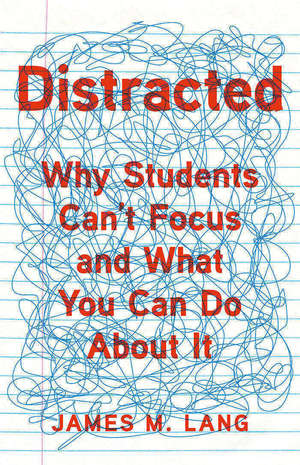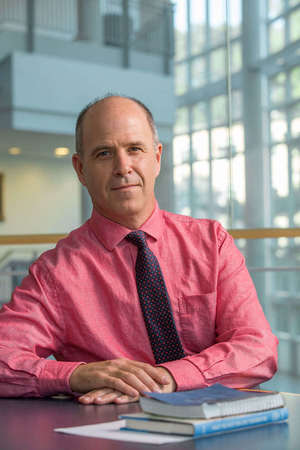
The Latin root of the word “distraction” means “torn apart” from something. Aristotle griped about rude snack-eating theatregoers. St. Augustine, the 4th-century theologian, lamented that the sight of a lizard disturbed his prayers. Today students sneaking peeks at smartphones fracture their attention and drive teachers to distraction. The average length of a college student’s attention span is six minutes, according to a 2013 study.
James Lang ’91 contends in his new book Distracted: Why Students Can’t Focus and What You Can Do About It (Basic Books, 2020) that this mental malady can be cured in classrooms — if teachers apply correct tactics. Lang is an English professor at Assumption University and director of its Center for Teaching Excellence. We caught up with him for this focused conversation:
Isn’t distraction worse now than ever?
From biological and historical perspectives, our brains have always been easily distractable organs. What’s different today — what feels different — is our devices have gotten better at playing on our distractable brains. They are intensifying a pre-existing condition. So we feel more distracted. It’s not that our devices are rewriting or reshaping our brains in some fundamental way.
You say teachers should not ban electronic devices. Why?
If you take out all the devices, there are still windows to stare out of and pencils to fool with. It’s quixotic to try to ban them to try to get everyone’s attention. It puts the classroom in an artificial bubble, if you make it a device-free zone all the time. What we should think about is how devices support or interfere with learning and have a context-driven policy.
Whether students use devices should depend on what’s happening. Are we having a discussion about a great work of literature? We probably don’t need them. If I’m lecturing and want students to retain material to consult later, maybe it’s better they have that on their laptops.

But you never bring your phone to class.
I sometimes see people teaching. I notice when students do group work, the faculty member might be doing something on his phone. We obviously should want to model practices we want students to do. When students are doing things, I want to be present to them and not fooling with my technology in the front of the room. Instead I should engage with them and help them as much as I can.
Mindfulness cures distraction, according to you, but it’s the teacher, not the students, who must be more self-aware. How does the teacher’s mindfulness help students be less distracted?
The results of research on whether student mindfulness and meditation improve their attention are very mixed. Instead, let’s have teachers become more mindful in how they pay attention to students — to pause, slow down, and become very aware of how they invite students into the learning experience.
You might have a strategy at the beginning of class where students write as funneling strategy, so their distractable brains enter a place of attention. The faculty member can also develop routines to help him or her slow down, pause, and prepare to enter the class and be more attentive and present to students.
What does it mean when you say a teacher must “think like a playwright and then like a poet”?
Playwrights have long had the challenge of sustaining the attention of people through two or three hours of an experience in which they sit in chairs and watch something. They are transparent about structure. You get a program that tells how the event will unfold. Those experiences have variety — acts, scenes, intermissions. Teachers need to think about class experiences as modular ones in which several clearly demarcated things happen, so students can catch their cognitive breath.
Poets help us renew our sense of wonder. What teachers need to do is design experiences that reawaken the wonder of students to everyday course content by taking striking new approaches to a poem, theory or problem.
I call these “signature attention” activities. The germ of the idea for the book came from an art historian. She knew museumgoers spend about seven seconds looking at each painting. She had her students go to our local art museum every week to look at the same painting and write a new essay each week — 13 two-page essays — about the same painting. That’s the creative thinking teachers need.
Aren’t you asking too much of teachers? Not everyone can be a brilliant performer in class.
All teachers know there are unsolved mysteries and fascinating problems in their disciplines. I argue curiosity is a great driver of attention. We come into class and say, “OK, here’s content for you.” Instead begin by stirring up curiosity and say, “I want to tell you about something strange we don’t understand.” That gets students curious. Then the content becomes, “OK, now I’ve got you curious. I want to show something to help you think through this problem.” That doesn’t require great skills as a lecturer. It’s about finding curious spots and focusing on them.
How do you prevent your devices from distracting you?
My advice for teachers and humans is worry less about being distracted and worry more about being deliberate about where you put your attention. I am very deliberate about putting aside a certain amount of time when I’m in my office writing. All tabs and email are closed for an hour’s worth of dedicated writing. I get 15 minutes to fool around on Twitter or answer emails and then write for another hour. At dinner, we put our devices away. After that, it’s anything goes.
Interview by George Spencer, a freelance writer based in Hillsborough, North Carolina.